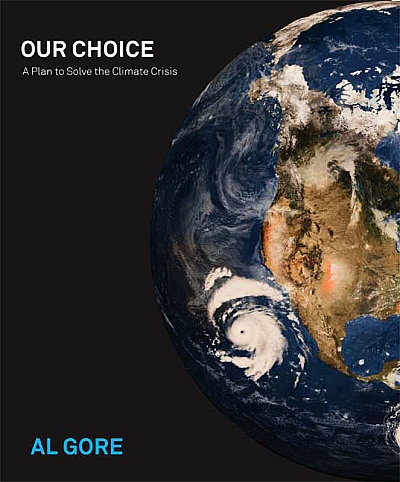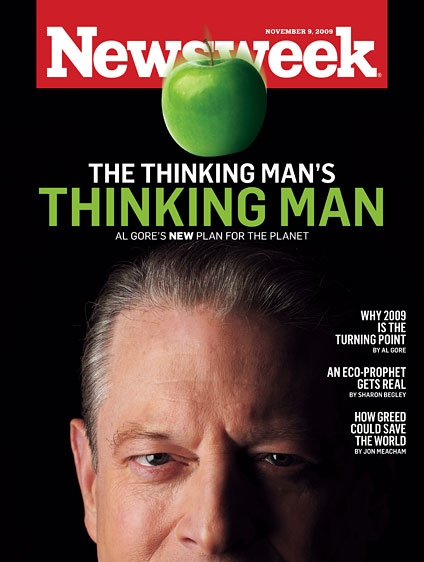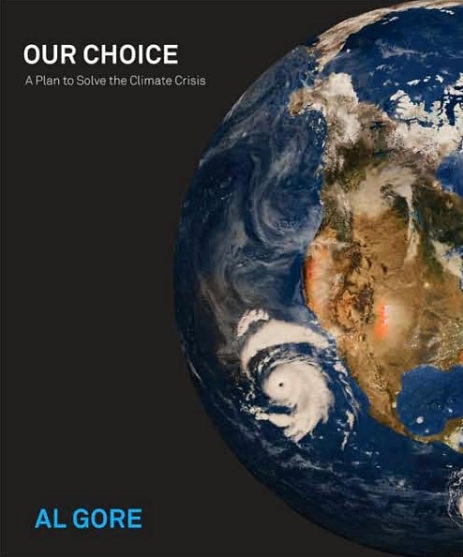 The long-awaited sequel to An Inconvenient Truth comes out Tuesday, Nov. 3. If you want a preview, Al Gore and the book are featured in an excellent Newsweek cover story, The Thinking Man’s Thinking Man.
The long-awaited sequel to An Inconvenient Truth comes out Tuesday, Nov. 3. If you want a preview, Al Gore and the book are featured in an excellent Newsweek cover story, The Thinking Man’s Thinking Man.
In September, Nature Reports Climate Change asked me (and several others) to suggest three books to read ahead of the Copenhagen conference. Of those, they then asked me to review Gore’s new book, Our Choice: A Plan to Solve the Climate Crisis:
When your last work led to an Oscar and Nobel Prize, anticipation is high on the sequel. And former US Vice President Al Gore’s new book delivers. Our Choice, due out in November, is a wonderfully readable treatise on climate solutions. Whereas An Inconvenient Truth framed the crisis that climate negotiations are tackling, this followup spells out what needs to be done.
Based on 30 of Gore’s ‘Solutions Summits’ as well as one-on-one discussions with leading experts across multiple disciplines, the book aims, in Gore’s words, “to gather in one place all of the most effective solutions that are available now.” Gore naturally focuses on energy, the source of most anthropogenic greenhouse gas emissions, and discusses many underappreciated strategies such as concentrated solar thermal power and cogeneration. He also devotes a full chapter to soil, a major carbon sink that is gradually degrading. Farming strategies for restoring soil carbon are described, including biochar, a porous charcoal that can potentially enhance the soil sink while providing a source of low-carbon power. And like its PowerPoint-based predecessor, Our Choice is replete with lush photos and simple but powerful charts. This [is] a must-read book for those who want a primer on all the key solutions countries will be considering at Copenhagen.
I was at one of the Solutions Summits, as long-time readers know (see “My Al Gore story“). I was interviewed by Newsweek about that Summit for their cover story:
Gore assigned each speaker at the summits a half dozen or so questions: Is nuclear power a viable solution? How can new photovoltaic technologies enter the market? He moderated every discussion, and no one remembers him ever glancing at his iPhone during even the most eye-glazing PowerPoint slides (”differentiation of value chain strategies”). Every panel at the New York meetings ran late, recalls Joseph Romm, who oversaw the Department of Energy’s renewables program from 1995 to 1998, as Gore asked question after question. “It was a fire hydrant of information,” says Romm, and it taught even experts things they didn’t know “about the latest technologies and strategies for clean energy.” Gore also hosted a reception afterward, where he betrayed no doubt that everyone would find everything as fascinating as he did. “Have Tim tell you all about soil carbon!” he said to one scientist. “Gore bothers to come talk to us,” says climatologist Gavin Schmidt of NASA’s Goddard Institute for Space Studies. “Most other politicians are too busy: ‘Just give us the talking points.’ He’s the only politician who’s interested in the nuts and bolts of the science—and the only one who knows what a hydroxyl radical is.”
Like Gore, I learned a lot from the summits. Here is what I wrote in January 2008:
For the last three days I attended a small climate solutions summit hosted by the former Vice President and current Nobel Laureate. It was off-the-record, so I can’t report on presentations directly, but they have made me a lot smarter about the latest technologies and strategies for clean energy, which will inform my blogging this year on climate solutions. I will say now as an aside that I have become much more bullish on the potential for large-scale solar photovoltaics as a result of attending these meetings. The VP asked me to speak for seven minutes on hydrogen at dinner Wednesday. Before dinner, I gave him a copy of the brand-new paperback edition of — warning, shameless product placement — Hell and High Water. He looked it over for a few minutes and said, deadpan,
I have only one problem with this book—this blurb on the back here that says, “If you buy only one book about global warming, make it Hell and High Water.” I just can’t agree with that.
When he introduced me that night, he repeated the line to great laughter.
BTW, in case it wasn’t obvious from his movie, the VP has a terrific sense of humor — and not just in his delivery timing of canned jokes, but in quick, impromptu one liners, like the one above, many of them self-deprecating (one of the speakers from a web-based company thanked him for his work accelerating the Internet, and he said something like, “You heard I had something to do with the internet?”).
And in case this wasn’t obvious from his movie, he has an encyclopedic knowledge of all things related to climate, energy, science, and technology.
I didn’t realize until I read the Newsweek piece that the VP had a similar reaction to the PV panel:
By all accounts, Gore was open to changing positions he brought to the summits. He originally thought that concentrated solar thermal power, in which the sun heats liquids that then power an electric generator, is superior to photovoltaics, in which sunlight produces electricity directly (PVs are the solar panels sprouting on rooftops these days). But “the PV industry surprised people over the last three years with the speed at which costs dropped,” says Cornelius, who is now at Hudson Clean Energy, a private-equity firm. Gore came around. “We are at or near a threshold beyond which photovoltaics will actually have a cost advantage” over concentrated solar as well as fossil fuels, Gore writes. He likes the fact that they can be deployed in small installations—those rooftops—whereas solar thermal projects are immense; he’s impressed that the price of photovoltaics is dropping while their efficiency is rising, thanks to new materials and manufacturing techniques. “Photovoltaics are a prime example of where the developmental pathway had a big impact on my conclusions,” Gore said at his home last month. “The rate of cost reductions and increases in efficiency for PVs is very impressive. PVs probably overtakes concentrated solar thermal within the next half year.”
I’m not certain one can directly compare PV and solar thermal. And I still think solar thermal will deliver more kilowatt-hours this century than any other form of low carbon electricity (see Solar Baseload—a core climate solution) particularly because it is so much cheaper and efficient to store thermal energy than electricity, and there are no obvious production bottlenecks for CSP. But this summit did convince me to include a full wedge of PV in “How the world can (and will) stabilize at 350 to 450 ppm: The full global warming solution,” along with 3 wedges of CSP.
 The Newsweek article is by Sharon Begley, a journalist who definitely gets global warming—see Newsweek’s Science Editor explains why climate change is “even worse than we feared” and how “a consensus has developed during IPY that the Greenland ice sheet will disappear.”
The Newsweek article is by Sharon Begley, a journalist who definitely gets global warming—see Newsweek’s Science Editor explains why climate change is “even worse than we feared” and how “a consensus has developed during IPY that the Greenland ice sheet will disappear.”
And for those who want to learn about soils and biochar, the book has a good chapter:
Gore loves plants and soils as only a former farm boy can (well, a summertime farm boy: as a kid he spent the school year in Washington, where his father was a senator). He regales you with numbers: more CO2 is emitted from burning and destroying forests—20 to 23 percent of the annual total—than from all the world’s cars and trucks; only by the 1980s did CO2 from fossil fuels overtake that from deforestation, which accounts for 40 percent of the CO2 increase since the 1800s.
The potential for soils to absorb more of the CO2 that our utilities, factories, and vehicles spew poses a dilemma for Gore, one of two where his scientific and political instincts collide. With better management, soils could sequester much more carbon than they do now. The question is how much more. Soils scientist Rattan Lal of Ohio State University was surprised to get a call last summer (”Vice President Gore would like to talk to you”) that began, “I have 15 or 20 questions about soils and climate for you.” Lal calculates that if more farmers adopted mulching, no-till farming, and the use of cover crops and manure, 3,700 million acres worldwide could sequester 1 gigaton per year of CO2, roughly 12 percent of annual global emissions. Other experts are even more sanguine. “If we feed the biology and manage grasslands appropriately, we could sequester as much carbon as we emit,” says Timothy LaSalle, CEO of the Rodale Institute, who presented at two summits. The political clash is this: if you tell people soils can be managed to suck up lots of our carbon emissions, it sounds like a get-out-of-jail-free card, and could decrease what little enthusiasm there is for reducing those emissions—as one of Gore’s assistants told LaSalle in asking him to dial down his estimate. (He didn’t.)
To his credit, Gore sides with the science, letting the political chips fall where they may. He writes that soils could sequester an additional 15 percent of annual global CO2 emissions from fossil fuels. That could cut 50 parts per million of CO2 from the atmosphere over the next 50 years. (We are now at 387, up from 280 before the industrial era, with 450 ppm or even less a dangerous level.) To encourage changes in agriculture that would foster carbon sequestration, Gore advocates moving away from price supports and toward paying farmers for “how much carbon they can put into and keep in their soil,” he says. Paying farmers to sequester carbon might jump-start the use of biochar, which Gore calls “one of the most exciting new strategies for restoring carbon to depleted soils, and sequestering significant amounts of CO2.” Biochar, which he learned about during a 1989 trip to the Amazon, is basically porous charcoal. Made by burning switch grass, corn husks, and other waste, it can absorb CO2 like a charcoal filter in a cigarette absorbs gases. Gore estimates that biochar could sequester 40 percent of annual CO2 emissions.
Begley notes one especially unexpected chapter in the book:
But because of one sentence, and one chapter, it does surprise. The chapter is an astute analysis of the psychological barriers that keep most Americans from taking the threat of climate change seriously, his acknowledgment that emotion, not just reason, drives the decisions people make. The sentence is this: “Simply laying out the facts won’t work.”
… Gore is a canny-enough politician to know that change of this magnitude takes time, and that politics tends to trump science. A new poll by the Pew Research Center found sharp declines in the numbers of Americans who believe there is solid evidence that the world is warming (57 percent, compared with 71 percent in April 2008), and in how many believe it is because of human activity (36 percent vs. 47 percent). Gore blames this on the boatloads of money the coal and oil industries have spent to muddy the science and confuse the public…. His favorite quote in Our Choice is from the philosopher Theodor Adorno (1903–1969): “The conversion of all questions of truth into questions of power … has attacked the very heart of the distinction between true and false.”
The piece concludes with Gore’s native optimism:
“You know, the political system is [like climate] also nonlinear,” Gore says. “I’ve been waiting a long time for that tipping point,” when politicians and the public recognize the threat of climate change and act to avert it. “But I think we’re closer than ever. Reality does have a way of knocking on the door.”
Walking back through the house, I ask Gore again whether he believes the sanguine vision of Our Choice will come to be. He points to solar panels on his roof, and to his driveway, 300 feet beneath which seven geothermal wells gather the planet’s warmth to heat and cool his house. “I have to,” he says.
Our Choice is really the anti-SuperFreakonomics. I’m sure it will be widely attacked by the deniers and delayers, so no doubt I’ll be blogging about it more this month. The bottom line is that besides being informative, Our Choice is a truly beautiful book page after page, and I highly recommend it, particularly for those who want a broad overview of the key strategies for preserving a livable climate.



